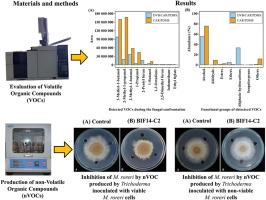秘鲁亚马逊地区原生木霉对霉菌的拮抗活性及最活跃菌株的挥发性代谢物分析
IF 3.3
3区 农林科学
Q2 PLANT SCIENCES
引用次数: 0
摘要
可可(Theobroma Cacao L.)被称为“神的食物”,是一种具有重要营养和经济价值的作物。木霉是一种很有前途的生物防治剂,可以防治由霉霉引起的霜性豆腐病,如果管理不善,可使产量降低100%。本研究对来自秘鲁亚马逊地区的10株木霉进行了体外抑菌活性评价。共培养过程中产生的挥发性有机化合物(VOCs)和非挥发性有机化合物(nVOCs)均对墨氏杆菌有抑制作用。菌株BIF7-C1对VOC的抑制作用最强(45.5%),菌株BIF14-C2对nVOC的抑制作用最强(22.3%)。由于菌株BIF7-C1具有优异的性能,我们选择菌株BIF7-C1进行挥发性分析,采用固相微萃取(SPME)和气相色谱-质谱联用(GC-MS)技术。采用两种SPME纤维:碳纤维/二乙烯基苯/聚二甲基硅氧烷(CAR/DVB/PDMS)和碳纤维/聚二甲基硅氧烷(CAR/PDMS)。通过CAR/DVB/PDMS鉴定了25个化合物,包括2,5-二甲基呋喃、2-甲基-1-丙醇和1,2,3-三甲基苯。CAR/PDMS共检测到22种化合物,其中3种是在共培养过程中特有的挥发性有机化合物(甲乙酸乙酯、β-新丁香烯、1,3,4,5,6,7-六氢-2,5,5-三甲基- 2h -2,4a乙炔萘)。这种纤维还显示出更高的醇、醛、酯和倍半萜含量。这些发现支持了本地木霉菌株作为霜冻荚果腐病生物防治剂的潜力,并突出了BIF7-C1作为进一步化学和功能研究的有希望的候选者。本文章由计算机程序翻译,如有差异,请以英文原文为准。

Antagonistic activity of native Trichoderma spp. against Moniliophthora roreri and volatile metabolite profiling of the most active strain in Amazonas, Peru
Cacao (Theobroma cacao L.), known as the “food of the gods”, is a crop of major nutritional and economic importance. Trichoderma spp. are promising biocontrol agents against frosty pod rot caused by Moniliophthora roreri, which can reduce yields by up to 100 % under poor management. In this study, ten native Trichoderma strains from Amazonas, Peru, were evaluated for antifungal activity in vitro. Both volatile organic compounds (VOCs) and non-volatile organic compounds (nVOCs) produced during co-culture inhibited M. roreri. Strain BIF7-C1 showed the strongest inhibition among VOC assays (45.5 %), while strain BIF14-C2 exhibited the highest nVOC effect (22.3 %). Because of its superior performance, strain BIF7-C1 was selected for volatile profiling using solid-phase microextraction (SPME) coupled to gas chromatography-mass spectrometry (GC-MS). Two SPME fibers were employed: Carboxen/Divinylbenzene/Polydimethylsiloxane(CAR/DVB/PDMS) and Carboxen/Polydimethylsiloxane (CAR/PDMS). With the CAR/DVB/PDMS, 25 compounds were identified, including 2,5-dimethyl furan, 2-methyl-1-propanol, and 1,2,3-trimethyl benzene across the three culture systems. With the CAR/PDMS, 22 compounds were detected, among them three VOCs uniquely present during co-culture (ethyl tiglate, β-neoclovene, 1,3,4,5,6,7-hexahydro-2,5,5-trimethyl-2H-2,4a ethanonaphthalene). This fiber also revealed higher abundance of alcohols, aldehydes, esters, and sesquiterpenes. These findings support the potential of native Trichoderma strains as biocontrol agents against frosty pod rot and highlight BIF7-C1 as a promising candidate for further chemical and functional studies.
求助全文
通过发布文献求助,成功后即可免费获取论文全文。
去求助
来源期刊
CiteScore
4.30
自引率
7.40%
发文量
130
审稿时长
38 days
期刊介绍:
Physiological and Molecular Plant Pathology provides an International forum for original research papers, reviews, and commentaries on all aspects of the molecular biology, biochemistry, physiology, histology and cytology, genetics and evolution of plant-microbe interactions.
Papers on all kinds of infective pathogen, including viruses, prokaryotes, fungi, and nematodes, as well as mutualistic organisms such as Rhizobium and mycorrhyzal fungi, are acceptable as long as they have a bearing on the interaction between pathogen and plant.

 求助内容:
求助内容: 应助结果提醒方式:
应助结果提醒方式:


